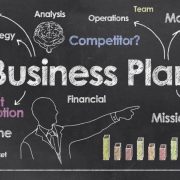How to create a Business Plan in 4 hours – Part 2
This post is by Giles Ellis, an experienced business coach and Director at GECA Chartered Accountants. If you need help unlocking your business potential, then Giles can help.
Having completed Part 1 of Creating a Business Plan in 4 hours, you will now have a one page template that states your business’s Vision and its Purpose. You have identified what the business needs to deliver to you and the Core Values that provide the basis for how you will do this. Now we are going to delve into the detail to operationalise your strategy – by setting goals for the next 12 months, along with actions to achieve and metrics to ensure you’re clear around what success looks like.
5.Revenue Targets
Under “What we want to achieve” section, write Gross Revenue Target. If you have an existing financial forecast, use the projected annual revenue figure. If not, see the PlusOne website for a financial forecast template. If appropriate, divide the Gross Revenue figure by 12 to get a monthly target (not relevant for businesses with seasonal variation). Now add any other relevant high level financial measures such as Gross or Net Profit and a monthly target.
Note the Gross Revenue Target should tie back to your “What we want to achieve” statements.
6.Key Performance Indicators (KPIs)
Head up the next section in the right hand column with Key Performance Indicators (KPIs). These are the key business drivers and identifying these enables business owners to measure progress accurately and then apply strategies and tactics to improve each KPI.
Start by listing as many KPIs as you think are appropriate for your business. These will be drivers of your business and are levers, that if pulled, can have an impact on your results. Your KPIs need to be measurable on a daily, weekly or monthly basis.
For example, 5 KPIs that drive Sales are client retention rate, leads generated, sales conversion rate, average transaction value and average dollar sale.
Now rank your KPIs from most important and include the top 5 in your business plan. You will need to ensure your selected set of KPIs covers all core business areas, and also decide which of these will be key levers for change – not just for the coming 12 month period, but running through your entire strategic plan.
The next two sections are quick and easy to complete.
7.Our Ideal Client / Customer
Consider who you would like to work with and describe this customer in one sentence. Think about the Vision for the business and how the ideal customer would fit in with the Vision. Now complete the following sentence and enter on your Business Plan; “Our ideal customer is…”
8.Our Value Proposition (for ideal customers)
The Value Proposition is one of the most important, if not the most important, parts of your business plan. Think of it as your ‘elevator pitch’ that summarises what you do and for who. It can be shared with customers and staff and is a powerful business tool.
Consider the following and spend 25 minutes brainstorming the things that describe your value proposition to your ideal customer.
- Why should your customers do business with you?
- What makes you stand out from the competition?
- What is your point of difference?
- What objections from customers have you overcome that your competitors may not have?
Now complete the following statement “I help target market do topic so that benefit. If you have three main problems you should call us.”
For example “We help small to medium sized business owners unlock their business potential so they improve performance and increase profits. If you want to grow the wealth of your assets, have your business running more efficiently and sleep at night knowing your assets are fully protected, you should call us now on 0800 7587 766.”
9.Our Most Critical Challenge
Write down as many critical challenges to be addressed in the next 12 months and rank in priority. Now include the most important critical challenge in a new section on your Business Plan under the Ideal Client section.
10.Opportunities / Vulnerabilities We Must Manage
The purpose of this section is to identify key opportunities to take advantage of and vulnerabilities to be addressed. Consider the following:
- What keeps you awake at night?
- What’s happening in your industry that you need to respond to?
- How much family time are you getting?
- How much YOU time are you getting?
These issues are often identified by doing a SWOT analysis and a SWOT template is available here for you to complete your own SWOT analysis. Now include these in a section alongside the Critical Challenge.
The opportunities and vulnerabilities identified are often used as the basis for Goal Setting in Part 3 of How to create a Business Plan in 4 hours.
Good luck creating your business plan and remember, if you need help to do this, contact Giles or his team on 0800 758 766 or sign up for our business planning service.






